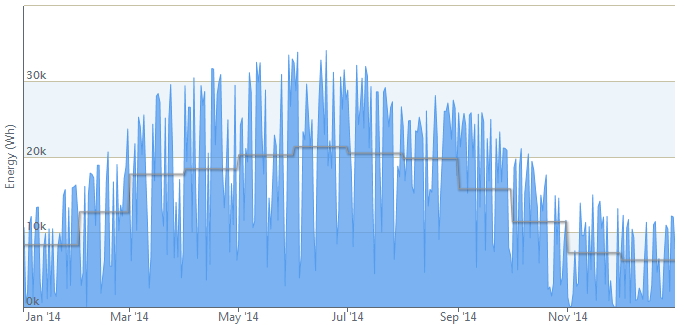An easy way to create a Negawatt is to turn off the light when you leave the room, you would be surprised how quickly this can add up by simply changing your behavior which costs you nothing.
While this concept is not normally applied to solar energy produced, I sat down and looked at the numbers for my solar energy array to see how much energy I am saving. Below is a chart showing the actual energy produced by my solar array for the year of 2014.
The gray line represents the average monthly estimated power which totals 5.45 MWh for the year. My 31 panel 5.7KW solar array produced more power than estimated which is typical for Enphase micro inverters, so I actually generated 5.7 MWh. In my mind these are also Negawatts. In terms of dollars, my utility charges 13.8 cents per kilowatt hour, so this means that I have saved $786.60 for the year on my electric bill. If I were still paying off the loan on my solar array at a low interest rate, this would represent almost half the annual loan payment. Since I paid off the loan thanks to an inheritance from my Dad, this enhances the "Negabucks" for me.
Of course there is less value in installing a solar array if you have not already significantly increased the efficiency of the electrical usage in your home. When we purchased our newly constructed home in 2001, the light fixtures all had 100 W incandescent lamps installed in them. The first thing we did was replace them with CFL's that used only around 13-15 W. I think we replaced around 12 lamps, and since then we replaced those with more efficient LED lamps at 7-9 W. (Here is a handy chart comparing light bulb types and costs). By reducing our load, we reduced the size of the expensive solar array significantly. By the way, we disposed of the old 100 W incandescent lights by shooting them with my pellet rifle!
Of course there is less value in installing a solar array if you have not already significantly increased the efficiency of the electrical usage in your home. When we purchased our newly constructed home in 2001, the light fixtures all had 100 W incandescent lamps installed in them. The first thing we did was replace them with CFL's that used only around 13-15 W. I think we replaced around 12 lamps, and since then we replaced those with more efficient LED lamps at 7-9 W. (Here is a handy chart comparing light bulb types and costs). By reducing our load, we reduced the size of the expensive solar array significantly. By the way, we disposed of the old 100 W incandescent lights by shooting them with my pellet rifle!
If we assume that each 100 W lamp is used an average of 4 hours/day, then it would use approximately 146 kWh/year, so all 12 lamps would use 1752 kWh/year. By replacing them with 7 W LED lamps they would use approximately 122 kWh/year - a Negawatt rating of over 1629 kWh/year. At our electric rates that adds up to a Negawatt savings of $224 per year. These kinds of numbers make the concept quite real and tangible.

No comments :
Post a Comment
I welcome all thoughtful comments and feedback!